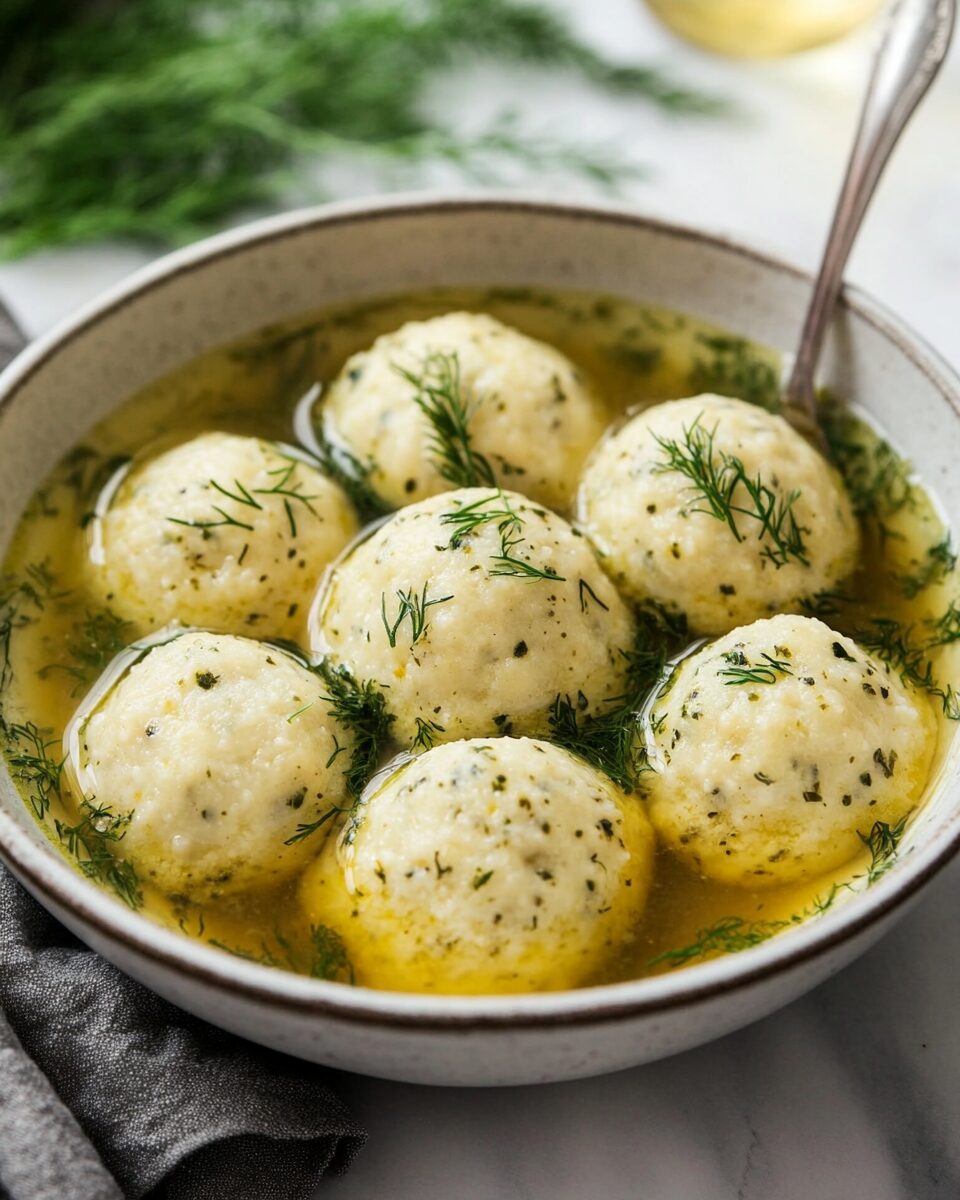A comforting classic, Matzah Ball Soup with Herb Infused Broth is the perfect dish for cozy evenings or festive gatherings. Light, fluffy matzah balls float in a flavorful broth enriched with fresh herbs, creating a warm, aromatic experience in every spoonful.
FULL RECIPE
Ingredients
- 1 cup matzah meal
- 4 large eggs
- 1/4 cup vegetable oil or schmaltz (chicken fat)
- 1/4 cup water or chicken broth
- 1 teaspoon salt
- 1/2 teaspoon black pepper
- 1/2 teaspoon garlic powder
- 1/4 cup fresh parsley, finely chopped
- 10 cups chicken broth
- 2 carrots, peeled and sliced
- 2 celery stalks, sliced
- 1 small onion, diced
- 2 cloves garlic, minced
- 1 bay leaf
- 4 sprigs fresh dill
- 4 sprigs fresh thyme
- Salt and pepper to taste
Directions
- In a large bowl, whisk together eggs, oil, water, salt, pepper, and garlic powder.
- Stir in the matzah meal and chopped parsley until fully combined.
- Cover the mixture and refrigerate for at least 30 minutes to firm up.
- While the mixture chills, bring chicken broth to a simmer in a large pot.
- Add carrots, celery, onion, minced garlic, bay leaf, dill, and thyme to the broth.
- Simmer the broth gently for 20 minutes to allow the flavors to infuse.
- Wet your hands and form the matzah mixture into 1-inch balls.
- Carefully drop the matzah balls into the simmering broth.
- Cover the pot and cook for about 30–35 minutes, until matzah balls are puffed and cooked through.
- Season the broth with additional salt and pepper to taste.
- Remove herb sprigs and bay leaf before serving.
- Ladle soup into bowls, making sure each serving has matzah balls and vegetables.
Nutritional Information
- Calories: 220 per serving
- Protein: 8g
- Fat: 12g
- Carbohydrates: 18g
- Fiber:2g
- Sodium: 850mg
The Cultural Significance of Matzah Ball Soup
Matzah Ball Soup holds a special place in Jewish culinary tradition, often enjoyed during Passover and family gatherings. It symbolizes comfort, warmth, and the importance of tradition in Jewish households. The soup is a connection to generations past, offering both nostalgia and a sense of belonging at the dining table.
Origins of Matzah Ball Soup
The roots of Matzah Ball Soup can be traced back to Eastern European Jewish communities. Matzah itself is an ancient food associated with the Exodus from Egypt, and over time, it evolved into various culinary forms including the beloved matzah ball. This adaptation became a staple dish in Ashkenazi Jewish homes.
Why Herb Infused Broth Matters
Herb infused broth elevates the traditional Matzah Ball Soup by layering additional flavors and aromas. Fresh herbs such as dill, thyme, and parsley add depth, making the broth more fragrant and enjoyable without overpowering the delicate flavor of the matzah balls.
Texture Secrets for Perfect Matzah Balls
Achieving the ideal matzah ball texture—light and fluffy, yet firm enough to hold together—is an art form. Refrigerating the batter allows it to firm up, preventing overly dense or falling-apart results. Some prefer “floaters,” lighter balls that rise to the top, while others opt for “sinkers,” denser balls with a hearty bite.
How to Choose Your Broth
The broth forms the soul of the soup, and choosing a high-quality broth is crucial. Homemade chicken broth with slow-simmered bones provides the richest flavor, but well-chosen store-bought options can also work. Seasoning the broth properly ensures every spoonful delivers full-bodied taste.
The Importance of Fresh Herbs
Fresh herbs are key to making a truly aromatic broth. Dill adds a signature brightness, thyme imparts earthiness, and parsley provides a fresh, slightly peppery touch. Using fresh herbs instead of dried versions brings out a cleaner, more vibrant flavor profile.
Common Mistakes to Avoid
Overmixing the matzah ball dough is one of the most common pitfalls, leading to dense, rubbery balls. Another frequent mistake is boiling the broth too vigorously after adding the matzah balls, which can cause them to fall apart or become tough. Gentle simmering is key to perfect results.
Variations Across Families
Every family seems to have its own secret twist on Matzah Ball Soup. Some add a pinch of nutmeg or ginger to the dough, while others might enrich the broth with leeks or parsnips. These subtle differences create deeply personal versions of this classic dish.
How Matzah Ball Soup Fits into Holiday Meals
During Passover, when leavened bread is forbidden, matzah ball soup becomes a centerpiece of the meal. It offers a hearty, filling option that still honors the dietary restrictions of the holiday, helping maintain both spiritual observance and culinary satisfaction.
Modern Takes on Traditional Recipes
Chefs and home cooks alike have started to experiment with Matzah Ball Soup, introducing flavors like lemongrass, turmeric, or even coconut milk into the broth. While these innovations offer exciting new tastes, they still pay homage to the dish’s comforting roots.
Health Benefits of Matzah Ball Soup
Chicken broth is widely known for its immune-boosting properties, thanks to its rich supply of minerals and anti-inflammatory benefits. Adding fresh vegetables like carrots and celery contributes essential vitamins and antioxidants, making this soup a nourishing choice, especially during cold seasons.
How to Make It Vegetarian
Switching to a vegetable broth and omitting the schmaltz makes it easy to adapt Matzah Ball Soup for vegetarian diets. Some creative versions even incorporate finely chopped mushrooms or other umami-rich ingredients into the broth to retain depth of flavor.
Serving Suggestions
Matzah Ball Soup can be enjoyed as a starter or as a light main course. It pairs well with simple salads, roasted vegetables, or traditional Jewish side dishes like kugel. Serving it in wide, shallow bowls showcases the beautiful presentation of the matzah balls floating in golden broth.
Storage and Reheating Tips
This soup stores wonderfully for a few days in the refrigerator. Keep the matzah balls and broth separate if possible to prevent them from soaking up too much liquid. Reheat gently on the stovetop to preserve the delicate texture of the matzah balls.
Freezing Recommendations
Both the broth and the matzah balls freeze well individually. Place cooled matzah balls on a baking sheet to freeze them individually before transferring to a freezer-safe bag. The broth can be frozen in containers. Reheat the broth first and then gently warm the frozen matzah balls separately.
The Best Tools for Preparation
Using a large, wide pot helps accommodate the matzah balls as they expand during cooking. A cookie scoop or wet hands make forming uniform matzah balls much easier. A fine mesh strainer is helpful when making a clear, smooth broth.
Kid-Friendly Aspects
Children often love the soft texture and mild flavor of matzah balls. Involving kids in rolling the balls can make preparation a fun family activity. It’s also a great opportunity to share the traditions and stories behind the dish with younger generations.
Matzah Ball Soup Around the World
While traditionally Eastern European, variations of matzah ball soup have popped up globally. In the United States, it is commonly found in Jewish delis and comfort food menus. In Israel, you may find more Middle Eastern influences in the seasoning of the broth.
Adapting for Gluten-Free Diets
Although matzah meal is traditionally made from wheat, gluten-free matzah meal options are now widely available. These substitutes allow those with gluten intolerance or celiac disease to enjoy matzah ball soup without compromise on texture or flavor.
Conclusion
Matzah Ball Soup with Herb Infused Broth remains a timeless favorite that transcends simple sustenance. It embodies history, comfort, and community in every bowl. Whether enjoyed as part of a sacred holiday or simply as a cozy meal on a chilly night, it represents the best of tradition and the evolving nature of culinary creativity. With a few simple techniques and fresh ingredients, anyone can master this heartwarming dish and pass it along to future generations.






